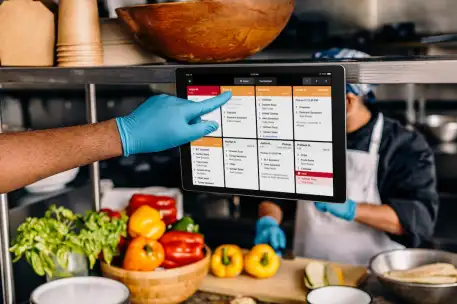In today’s fast-paced food service industry, optimizing order management and enhancing customer experience are crucial for staying competitive. One effective way to achieve this is by integrating self-service kiosks and Kitchen Display Systems (KDS) into restaurant operations. These technologies streamline processes, reduce errors, and significantly boost customer satisfaction. In this blog, we’ll explore how self-service kiosks and KDS can transform your restaurant’s efficiency.
What is a Self-Service Kiosk?
Self-service kiosks are interactive machines that allow customers to place orders directly. These kiosks feature intuitive interfaces where customers can browse menus, select items, customize their orders, and make payments. By reducing the need for cashier interaction, self-service kiosks not only speed up the ordering process but also improve order accuracy. This self-service approach enhances customer convenience and reduces wait times, leading to a more efficient service environment.
How Self-Service Kiosks Transform Customer Experience
Self-service kiosks revolutionize the customer experience by offering a streamlined ordering process. With an easy-to-use interface, customers can quickly browse through the menu, explore various options, and customize their orders according to their preferences. Additionally, these kiosks present upselling opportunities by suggesting complementary items or promotions. Many restaurants have successfully implemented self-service kiosks, resulting in reduced queue times and higher customer satisfaction.
Understanding the Kitchen Display System (KDS)
The Kitchen Display System (KDS) plays a pivotal role in modern kitchens by replacing traditional paper tickets with digital screens. Orders placed through self-service kiosks are transmitted directly to the KDS, which displays them in real-time. This digital interface helps kitchen staff view, prioritize, and manage orders more efficiently. With KDS, kitchen operations become more organized, reducing the chances of errors and delays in food preparation.
The Order Routing Process: From Kiosk to Kitchen
Order routing is a crucial feature of the self-service kiosk and KDS integration. Once a customer places an order through a self-service kiosk, the order is seamlessly routed to the KDS in the kitchen. This process minimizes manual errors and accelerates order fulfillment. By integrating these systems with existing restaurant management software, businesses can ensure that orders are transmitted accurately and promptly, further enhancing operational efficiency.
Key Features of Kitchen Display Systems
Kitchen Display Systems offer several key features that enhance kitchen operations:
- Order Prioritization: KDS allows for prioritizing orders based on factors such as order type, preparation time, and customer preferences. This ensures that high-priority orders are addressed promptly.
- Timers: KDS incorporates timers to track cooking durations, helping staff prepare orders within specified timeframes and reducing delays.
- Visuals: Digital screens in KDS provide clear and organized order details, making it easier for kitchen staff to manage and fulfill orders efficiently.
Future Trends in Self-Service and Kitchen Display Technologies
The future of restaurant technology is bright, with innovations in self-service and kitchen management continuously evolving. Emerging trends include advanced AI-driven kiosks, enhanced customer data analytics, and integration with other digital systems. Staying ahead of these trends can help your restaurant remain competitive and continue delivering exceptional customer experiences.
Takeaway
Self-service kiosks and Kitchen Display Systems are transforming the restaurant industry by enhancing efficiency, improving order accuracy, and elevating customer satisfaction. By adopting these technologies, your restaurant can streamline operations and provide a better dining experience for your customers. Ready to take your restaurant to the next level? Consider implementing self-service kiosks and KDS solutions today!

